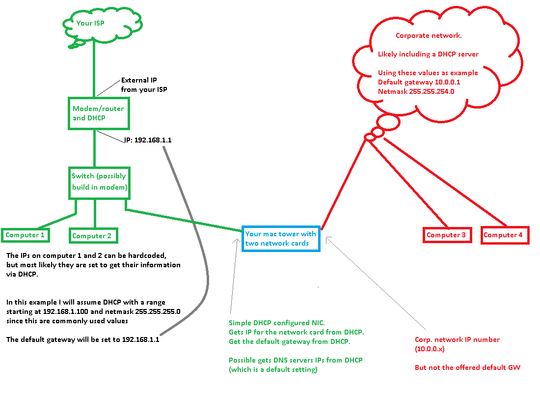The answer to the first two questions should be ask your corporate IT person.
If you really need to do it yourself then open a command prompt and check the output of these commands:
ifconfig (shows the IP addresses you are using)netstat -rn (shows the defined routes)
The third question is a bit harder. You wrote that Priority order states that the non-corporate network comes first. I assume this means the default gateway is set to the non-corporate network. If it was the other way around it would just have worked. Now you will have to find out what server(s) MS communicator tries to contact and add separate routes for that.
Edit:
This is how I understand your network.
 Lets say the corp. network gets plugged into the NIC called
Lets say the corp. network gets plugged into the NIC called en1.
Almost all larger networks use DHCP. This means your card will announce its presence on the red network (think it yelling 'Hi, I am here. Give me the information I need').
The DHCP server will respond and usually it will tell the the computer what it needs. Try this. I expect that you will get an IP number, netmask, a default gateway and the IP for the DNS servers.
The IP is what gets set on your NIC. Write this down because you might need it later. In this example I will assume you got 10.0.0.42
The netmask will tell you which part of 10.0.0.42 is your network, and which part is the identification for your computers. Combined these allow you to access the local corp. network.
If a computer is not on the local corp. network then your mac will send it to some computers who (hopefully) knows how to forward it. This is the default gateway. There is no guarantee that your corp. network uses one, but it is very likely and it is something we do not wish to use later on.
Now for the green ISP network.
I can be briefer because things are more or less the same. You are very likely to gets and IP, netmask, default gateway and DNS server IPs.
However you can only have one default gateway.
You wrote that you wanted to use the green network by default. So we will use the default gateway on this one.
This means that you can just connect the green network to en0 and let it auto configure, but that you want to manually configure the red network. This means that you will not be using DHCP on en1. Not using DHCP means you can create a conflict on that network (since we are no longer using the red DHCP server which is keeping IPs on the red network unique). So walk to corp. IT and ask for a fixed IP address. They will add that to the exclusion list on the DHCP server. I am going to assume you got 10.0.0.42 as IP number.
Now go to the Mac, boot with the green cable in en0, set for DHCP. You should be able to connect to the other green computers (test with ping) and to reach the internet.
Connect the red cable to en1. Do not set this on to DHCP. If you have a graphical network tool then enter these values: IP: 10.0.0.42 (the one given to you by IT), netmask 255.255.254.0 (also given to you by IT). You should now be able to connect the the corp. computers.
If you use a shell, use:
- ifconfig en1 10.0.0.42 netmask 255.255.254.0
- /sbin/route add -net 10.0.0.0 -netmask 255.255.254.0 -interface en1
The first command should configure the interface on en1 so it can send and receive on the corp. network. The second command tell your mac that if it want to connect to a computer on the corp. network (as in, any computer whose IP starts with 10.0.0.x) then it should communicate via en1.
This should answer your question, though I have one more paragraph because I thing you will run into problems with DNS. The DNS services provided by the ISP/green network will translate computer names to IP numbers for computers on the internet. They are unlikely to know about computer names in the corp.network. You might need to:
- Either set DNS to use the ones from the red corp. network (and hope those also resolve hostnames on the internet)
- Specify one nameserver from green and one from red. (Which will likely cause a timeout when you try to resolve something)
- Or use a hosts file. There are several posts on that subject on superuser.
 Lets say the corp. network gets plugged into the NIC called
Lets say the corp. network gets plugged into the NIC called
try R N in small letters (and yes, with wrong kerning that looks like an m). – Hennes – 2012-07-18T15:21:50.747
Ah, fair enough – better to put code into backticks then, for legibility. – slhck – 2012-07-18T15:30:05.837
Thanks but I don't understand the route command I have to use. whats the syntax? Using this link here as a guide:https://discussions.apple.com/thread/2605945?start=0&tstart=0
– Tony – 2012-07-18T17:24:52.990Let me ask something first so I know how specific I have to be in my answers. How well do you know TCP/IP and routing? Are you a windows admin (possibly with deep understanding of this) but no OS/X experience? Or an experienced OS/X user with .... (etc etc) – Hennes – 2012-07-18T18:07:48.613
I'm both a PC and Mac guy (currently working on a mac) and I know a bit about routing etc but clearly not enough to do what I want above. – Tony – 2012-07-19T12:35:04.957
Updated the post. Forgot to expand the part for the first question. It probably should contain
ipconfig getpacket en1. Still untested though since I do not have a mac. – Hennes – 2012-07-19T13:55:01.060